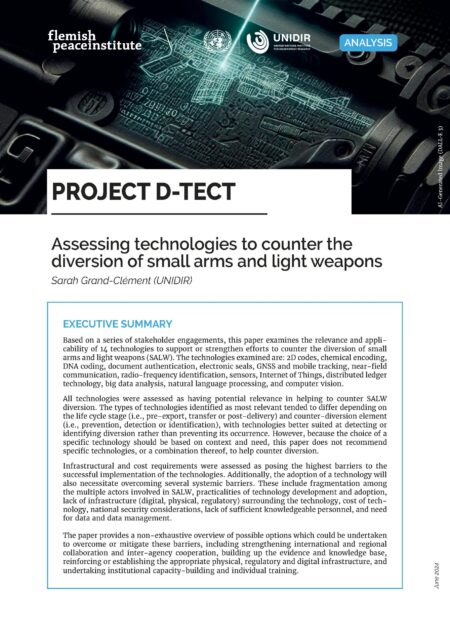Project D-TECT: Assessing technologies to counter the diversion of small arms and light weapons
Publication date: 26/06/2024
Based on a series of stakeholder engagements, this second Project D-TECT analysis by Sarah Grand-Clément (UNIDIR) examines the relevance and applicability of 14 technologies to support or strengthen efforts to counter the diversion of small arms and light weapons (SALW). The technologies examined are: 2D codes, chemical encoding, DNA coding, document authentication, electronic seals, GNSS and mobile tracking, near-field communication, radio-frequency identification, sensors, Internet of Things, distributed ledger technology, big data analysis, natural language processing, and computer vision.
All technologies were assessed as having potential relevance in helping to counter SALWdiversion. The types of technologies identified as most relevant tended to differ depending onthe life cycle stage (i.e., pre-export, transfer or post-delivery) and counter-diversion element(i.e., prevention, detection or identification), with technologies better suited at detecting oridentifying diversion rather than preventing its occurrence. However, because the choice of a specific technology should be based on context and need, this analysis does not recommend specific technologies, or a combination thereof, to help counter diversion.
Infrastructural and cost requirements were assessed as posing the highest barriers to the successful implementation of the technologies. Additionally, the adoption of a technology will also necessitate overcoming several systemic barriers. These include fragmentation among the multiple actors involved in SALW, practicalities of technology development and adoption, lack of infrastructure (digital, physical, regulatory) surrounding the technology, cost of technology, national security considerations, lack of sufficient knowledgeable personnel, and needfor data and data management.
The analysis provides a nonexhaustive overview of possible options which could be undertaken to overcome or mitigate these barriers, including strengthening international and regional collaboration and inter-agency cooperation, building up the evidence and knowledge base, reinforcing or establishing the appropriate physical, regulatory and digital infrastructure, and undertaking institutional capacity-building and individual training.
 Download PDF
Download PDF

